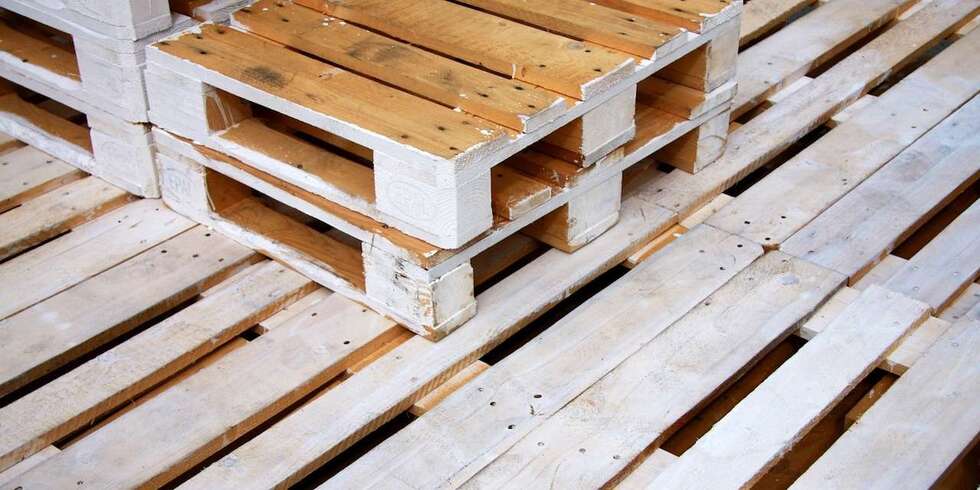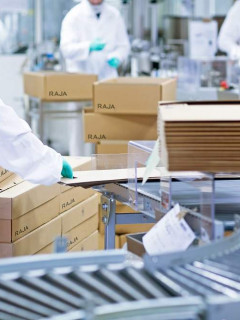Stacking logistics pallets can be a time-consuming and tedious task.
From organising the boxes to securing the pallet, there are various essential steps to follow. Are you sure that your operators follow them to the letter?
Discover all our advice on how to prepare and stack your logistics pallets while ensuring the safety of your operators and limiting the breakage of your goods.
This article was updated in February 2021.

- Even before preparing a pallet: choose it carefully
- Step 2 : Distribute the boxes on the pallet
- Step 3: Stack the boxes correctly
- Step 4: Protecting your logistics pallet
- Step 5: Handling the pallets
Even before preparing a pallet: choose it carefully
Not least of all, before you even prepare a logistics pallet, you need to choose it carefully.
There is a wide range of pallets available; you should choose the right one for you, depending on its size:
- Its size: if the EUR EPAL pallet (or European pallet) has standard dimensions, you may need a more customised pallet, such as a half-pallet. Estimate beforehand how much volume you will need, to minimise the empty space in your containers and optimise the transport of your goods.
- Its load capacity, i.e. the maximum weight it can support. Some pallets are specifically designed for heavy loads, others for lighter loads. Be careful to take into account not only its static load, but also its dynamic load (when it is carried during handling) and the rack weight (when it is stored on a rack).
- If you know that it will be potentially exposed to the elements, avoid wooden pallets and choose a plastic pallet, whose soles will resist contact with humidity. You can also, for example, choose to use second-hand pallets, if necessary.
If you need more details on the criteria for choosing between the types of handling pallets available, we recommend that you read our dedicated guide to the subject, which will help you make an informed choice for your logistics strategy

Step 2: Distribute the boxes on the pallet properly
Once you have carefully selected your pallet, you will need to distribute your cardboard boxes on it.
First of all, focus on filling up the space at the bottom of the pallet to ensure that the boxes are as stable as possible during transport and to avoid any damage to the goods.
To do this, you can use a pallet box. This is a cardboard tool that is usually the size of the pallet and is very useful for order picking. It allows you to place your boxes inside, thus respecting the maximum dimensions of the chosen logistic pallet. There is also a plastic pallet box model, which is resistant to the weather.
Step 3: Stack the pallet and boxes correctly
The stacking of boxes in a pallet must follow very precise rules, in order to ensure their stability, and to facilitate their storage and handling.
Here are 2 essential rules to apply when stacking a pallet:
- Be sure to select stackable cartons, suitable for transporting products on pallets.
- Position the heaviest and smallest boxes at the bottom of the pallet, with the lightest boxes gradually being positioned on top of them.
- Make sure thatthe top of the pallet is flat, so that the different pallets can be stacked ergonomically.
The ultimate aim of making the top of the pallet as flat as possible is to maximise the space available in the transport containers or in your warehouse. The more efficiently the pallets stack, the less empty space you will transport or store.
To achieve the ideal end result, don’t hesitate to prepare your pallet with a pallet cover, which will protect the top of your package.

Step 4: Protecting your logistics pallet
At this stage, your pallet contains all your goods, organised according to the essential rules that ensure its stability.
Now it’s time to protect your pallet as best you can.
Start by fitting your pallet with corner protectors, which will protect the corners of your pallet from bumps and scratches and ensure safe transport.
Then it’s time to wrap your pallet. You can :
- Do it by hand, but make sure you have the right equipment.
- Use a wrapping machine, which is recommended if you wrap more than 15 pallets a day, as it will prevent your operators from suffering from RSI.
Step 5: Handle the pallets
You probably already have the right equipment for preparing and stacking your pallets, such as plastic bins, which are used to transport bulk goods to be palletised in the warehouse.
But have you thought about how to make pallet handling easier for your operators?
To do this, choose the right handling and lifting equipment for your needs, for example, you might consider investing in..
- Forklifts, if you store your pallets on high shelves. Be sure to check the lifting height of the forklift and the maximum load of its forks, to really facilitate the loading and unloading of pallets of products.
- Pallet trucks, to increase the productivity of your teams and ensure their safety when moving pallets in warehouses. To find out more on this subject, go to our article How to choose your pallet truck?
- A pallet lifter, which (as its name suggests) raises the pallet on the floor, to facilitate stacking and limit the RSI linked to palletising movements.
After these few easy-to-remember steps, you are ready to ship strong, stable and safe pallets with confidence.















